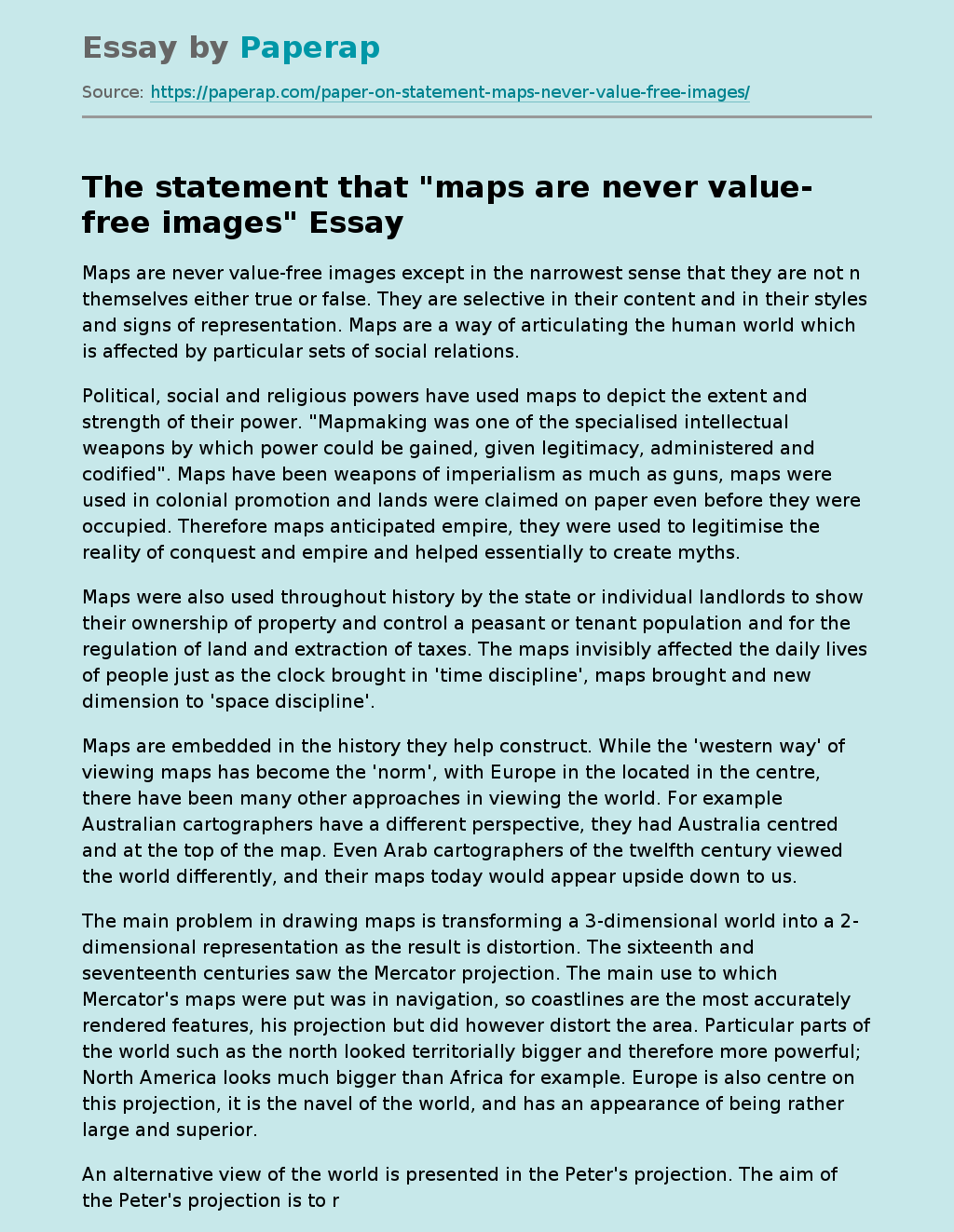Maps Are Never Value Free Images
The following sample essay talks about cards and how they are used. Read the introduction, body and conclusion of the essay, scroll down.
Maps are never value-free images except in the narrowest sense that they are not n themselves either true or false. They are selective in their content and in their styles and signs of representation. Maps are a way of articulating the human world which is affected by particular sets of social relations.
Political, social and religious powers have used maps to depict the extent and strength of their power.
“Mapmaking was one of the specialised intellectual weapons by which power could be gained, given legitimacy, administered and codified”. Maps have been weapons of imperialism as much as guns, maps were used in colonial promotion and lands were claimed on paper even before they were occupied. Therefore maps anticipated empire, they were used to legitimise the reality of conquest and empire and helped essentially to create myths.
Maps were also used throughout history by the state or individual landlords to show their ownership of property and control a peasant or tenant population and for the regulation of land and extraction of taxes.
The maps invisibly affected the daily lives of people just as the clock brought in ‘time discipline’, maps brought and new dimension to ‘space discipline’.
Maps are embedded in the history they help construct. While the ‘western way’ of viewing maps has become the ‘norm’, with Europe in the located in the centre, there have been many other approaches in viewing the world.
For example Australian cartographers have a different perspective, they had Australia centred and at the top of the map. Even Arab cartographers of the twelfth century viewed the world differently, and their maps today would appear upside down to us.
The main problem in drawing maps is transforming a 3-dimensional world into a 2-dimensional representation as the result is distortion. The sixteenth and seventeenth centuries saw the Mercator projection. The main use to which Mercator’s maps were put was in navigation, so coastlines are the most accurately rendered features, his projection but did however distort the area. Particular parts of the world such as the north looked territorially bigger and therefore more powerful; North America looks much bigger than Africa for example. Europe is also centre on this projection, it is the navel of the world, and has an appearance of being rather large and superior.
An alternative view of the world is presented in the Peter’s projection. The aim of the Peter’s projection is to represent area with maximum accuracy, it preserves area but at the expensive of the shapes of the landmasses becoming elongated and severely distorted.
Deliberate distortions of map content have been used throughout history for political purposes. Behind the mapmaker is a set of power relations and by manipulating scale, over-enlarging or moving topography or by using strong, suggestive colours, makers of propaganda maps have been a cause of the one sided view of geopolitical politics. Many wars have been fought as much in the contents of propaganda maps as through any other medium.
Maps show as much as they hide, the cartographer is essentially the author and they have the power to represent what they believe to be important or essential on the map. Also their name is usually hidden so that the map assumes as air of accuracy and objectivity. Monmonier states that “not only is it easy to lie with maps, it is essential”, maps have to omit certain details as it is not possible to include everything on a map and it to be still legible. Maps therefore simplify and the cartographer chooses the selected features that are to be presented on it so as to point us to a way of reading it.
‘Silences’ on maps exert a social influence through their omissions as much as through the features they depict and emphasise. There is an important political undercurrent in these ‘silences’. For example nuclear waste dumps are not shown on USGS topographical maps, so as not to cause the government embarrassment.
In early modern maps castle signs representing military of feudal rank appeared larger than villages despite the fact they occupy less ground. Their purpose was to heighten their perception of power.
Maps are never value-free images they construct rather than represent the world; they are a unique system of signs and are undermined by certain ideologies. The cartographer may also be biased in his choice of what is represented on the map and he is usually influenced by certain power relations. Maps cannot simply be taken for face value and one must be aware of what they do not say as much as what they do, in order to fully appreciate their power to manipulate.
Maps Are Never Value Free Images. (2017, Dec 22). Retrieved from https://paperap.com/paper-on-statement-maps-never-value-free-images/

